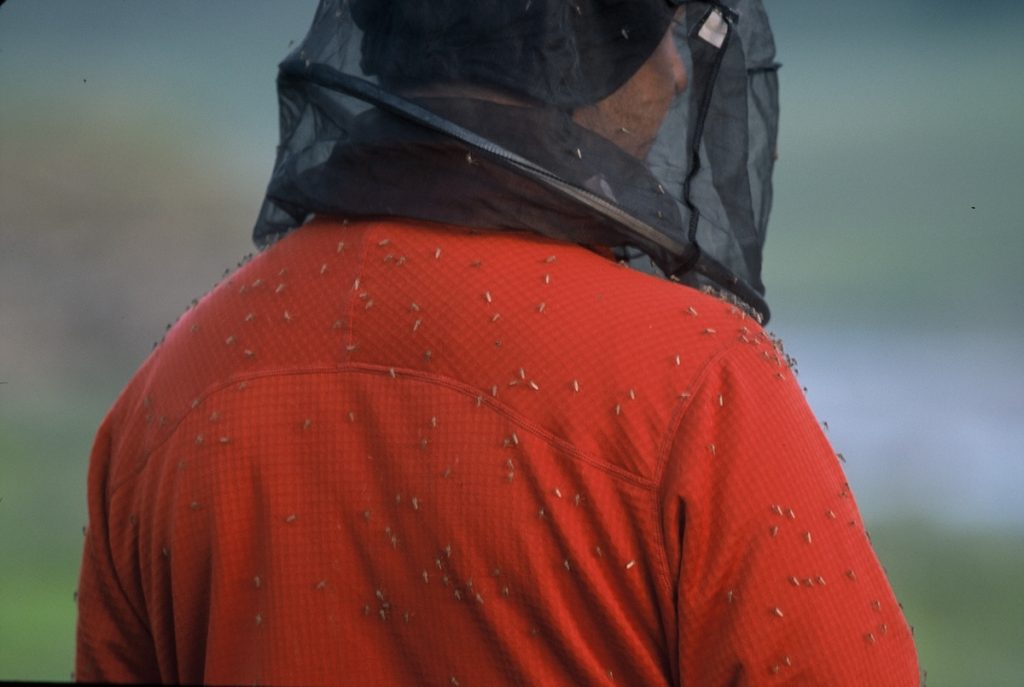North Slope Chronicles

Some of the best unfiltered water I’ve ever drunk cascaded over broad gravel bars along the Canning River – surging down the North Slope of the Brooks Range in the Arctic National Wildlife Refuge in Northeast Alaska.
Three friends were paddling in a raft, while I paddled in a one-man pack raft on our way to the Arctic Ocean. Seemingly, the days never ended as we paddled through the longest day of the year, during the third week of June, the Arctic sun dipping below the tundra for only two hours, as wolves howled and shaggy caribou huddled on the frigid Canning.
For three weeks we weaved between bedraggled strainers and thick ice still clinging to winter. Ironically, it was the winding rivers that offered reprieve and solace from massive swarms of mosquitoes, Alaska’s largest bird, while navigating our way through braiding rivers. We paddled down three rivers in all, beginning on the Upper Marsh Fork, the Canning, and finally the Staines River, where we could hear ice floes cracking and the surf booming on gritty barrier islands on the Arctic Ocean.
Lost
The Canning widened, separating the tundra two miles wide. All it took for me to become separated from my comrades was me paddling over a nondescript braided channel sweeping further to the northeast. The raft holding my friends remained in the main channel. At the time, as I bounced down the channel, I thought it would lead right back to them. Instead, it took me to the other side of the river.
I didn’t panic, but we were a long way from anything other than the North Slope of the Brooks Range, tundra, ice and Arctic wildlife. Things could’ve been worse, right? My biggest concern was returning to the main channel ahead of my friends. I didn’t want them getting ahead of me in fear I would miss them, and then none of us knowing what to do next. So, I paddled hard, taking every left channel braiding west in the swift-moving runnel.
It was a warm, sunny day on the river – shorts, sun-shirt, hat, sunglasses. My camera was in my dry bag along with my food. However, what proved to be the most vital piece of gear were my binoculars. Another fear I had was once I returned to the main channel, could I find high ground – a much-needed vantage point to scan for my paddling buddies. The Canning and the Staines rivers weaved through tundra that was mostly flat. I needed high ground.

Of course, there were some distractions as I worked my way to the main channel. One of those was the biggest moose I’ve ever seen. I saw the bull mangling dense willows on an island in the middle of the Canning. I thought I could approach from my pack raft undetected because the moose was partially concealed in the willows, but also because its absurdly girthy antlers were destroying those willows.
It either saw me or smelled me, because once I butted my pack raft on the shore of the gravelly isle, all went silent in the willows. It was incredible how something so large became so stealthy in those seemingly impenetrable willows. There was no way I was going to leave the pack raft. I didn’t even get out of it. There’s no messing around with a bull moose. I let it go and continued paddling for the main channel, my priorities hovering over me like a dark storm cloud.
Of Mud, Mosquitoes, and Memories
Partially relieved after reaching the main channel, my next priority was high ground. I needed to see over the top of the Canning and surrounding tundra. The last channel that led me to the main channel, also deposited me straight into the only bluff I saw for miles in every direction. I don’t believe I mentioned I was barefoot. I momentarily ditched my pack raft in a popular muddy wallow, where musk ox and caribou shared the same mucky bog.
Absolutely caked in gooey mud, I scrambled upward approximately 100 feet to my lofty perch. Accompanying me on my ascent were literally hundreds of mosquitoes. I had stirred them out of their muddy slumber after leaving my pack raft. I took my hands and wiped my legs, smearing hundreds of mosquitoes. They were so thick on my skin, that when I wiped them off, they transformed into this black, gunky paste, almost like crude oil. It didn’t matter, though. I was so focused on locating my friends.

I wanted to catch them upriver, floating toward me. It’s what I envisioned, and it’s what I received. They were a mile upriver. Despite the dark cloud of mosquitoes, I could see them through my binoculars. Once I had eyeballs on the main raft, I sprinted down the bluff in my longest strides with seemingly superhero speed. I dropped my gear in my pack raft without breaking stride, and dove into a brain freeze of 38-degree water. It not only took my breath away, but it momentarily washed away all the mosquitoes. More importantly I rid myself of any residual Arctic anxiety.
I easily accepted all the heckling my friends delivered, and reveled in the freezing, turquoise blue Canning River. Although tempted to veer off on my own after continuing, I kept close to the main raft and braiding channel that eventually converged with the Staines River. Along the way we smelled death on the river, still several miles from the lonely Arctic Ocean. After reaching the coast, we received a report from a lone seabird biologist monitoring nests in the tundra. An emaciated polar bear had left the ice on the Arctic Ocean and followed its powerful sense of smell three miles upriver to what turned out to be a caribou carcass.
It made me think of that burly moose, and being lost in a wilderness so grand, remote and even intimidating. I was just a mere visitor passing through one of the wildest places I’ve ever been, where apex predators still reigned supreme in the last of the Last Frontier.







